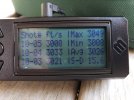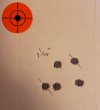Snakeoil
Well-Known Member
Well, I shot 1000 yds yesterday with my buddy's F-class .308. Since the range is only about 6 miles from my house, I might get the bug. Rather than jump in with both feet, I thinking of just dipping a toe or two into the shallow end of the pond.
I have a Rem 788 in .22-250. The round have to be supersonic at the target because they use electronic targets that require the bullet be supersonic in order to pick it up and display the shot placement on the screen. Now, I can buy jacketed bullets and go down that path. But I thought it might be fun to start off with powder coated cast bullets.
I imagine if I spend some time here the I might find the answers to my questions with a search. But I'm thinking that this thread may be a good place to record the adventure, blow by blow if it truly materializes. So, allow me to ask some basics.
1. How fast can I push a powder coated bullet? Can I achieve my goal of a supersonic projectile 1000 yds downrange? If the answer is no, then that pretty much ends this topic.
2. If this is possible, will my accuracy be sufficient to even bother trying? Velocity is one thing. Getting them in the black is another.
3. And if I'm still headed in a positive direction here, is there any brand/type of powder coat and/or process to apply it that would benefit my end goals of an accurate, supersonic round for 1000 yds?
4. And finally, if all the above is possible, suggestion for bullet type. I know that match jacketed bullets are boattail spitzers, some with hybrid ogives to provide centering and best possible BC. I don't expect to be able to find cast bullets that would work using jacketed bullet design feature. But I know there are spitzer types and a flat bottom with a gas check will be required.
I think the exercise would be fun. And I think it would also be a great learning experience.
I think those three basic questions need to be answered before I even consider proceeding.
At the risk of being a bit of an arsehole, I really don't want opinions based upon what somebody may have read somewhere or just feels the need to offer an opinion. I don't mind somebody sharing something that they have read, as long at they present it as such. What I'd really like, is to hear from those with first hand experience with supersonic powder coated cast bullets.
And I realize that I might be dreaming to think I can do this with the .22-250. But guys are shooting 6mm PRC at 1000 yds and doing well. So, knowing that the .22-250 is a flat shooting little devil, it should do the job nicely, at least for my initial intentions. Don't forget, I'm toe dipping here, not going off the 10 meter board.
Thanks.
I have a Rem 788 in .22-250. The round have to be supersonic at the target because they use electronic targets that require the bullet be supersonic in order to pick it up and display the shot placement on the screen. Now, I can buy jacketed bullets and go down that path. But I thought it might be fun to start off with powder coated cast bullets.
I imagine if I spend some time here the I might find the answers to my questions with a search. But I'm thinking that this thread may be a good place to record the adventure, blow by blow if it truly materializes. So, allow me to ask some basics.
1. How fast can I push a powder coated bullet? Can I achieve my goal of a supersonic projectile 1000 yds downrange? If the answer is no, then that pretty much ends this topic.
2. If this is possible, will my accuracy be sufficient to even bother trying? Velocity is one thing. Getting them in the black is another.
3. And if I'm still headed in a positive direction here, is there any brand/type of powder coat and/or process to apply it that would benefit my end goals of an accurate, supersonic round for 1000 yds?
4. And finally, if all the above is possible, suggestion for bullet type. I know that match jacketed bullets are boattail spitzers, some with hybrid ogives to provide centering and best possible BC. I don't expect to be able to find cast bullets that would work using jacketed bullet design feature. But I know there are spitzer types and a flat bottom with a gas check will be required.
I think the exercise would be fun. And I think it would also be a great learning experience.
I think those three basic questions need to be answered before I even consider proceeding.
At the risk of being a bit of an arsehole, I really don't want opinions based upon what somebody may have read somewhere or just feels the need to offer an opinion. I don't mind somebody sharing something that they have read, as long at they present it as such. What I'd really like, is to hear from those with first hand experience with supersonic powder coated cast bullets.
And I realize that I might be dreaming to think I can do this with the .22-250. But guys are shooting 6mm PRC at 1000 yds and doing well. So, knowing that the .22-250 is a flat shooting little devil, it should do the job nicely, at least for my initial intentions. Don't forget, I'm toe dipping here, not going off the 10 meter board.
Thanks.


